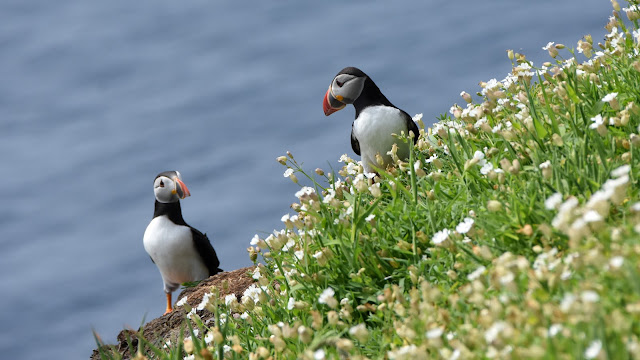Skellig Michael is the larger of the two Skellig Islands, located 12 kilometers west of Portmagee and Valentia Island, on the west coast of Ireland. At some angle, it looks like a pyramid standing in the ocean horizon. Hundreds of years ago, Christian monks lived here, built several beehive stone huts at the top of the hill. The ruin made it a World Heritage site. On 2016, Star War movie The Last Jedi was filmed here, the beehives became iconic for fans all over the world.
To me, it is one of few places in the world to see puffins up and close to their burrows. Puffins mate for life, every April they return to the same burrow, lay one egg, raise the chick till leaving on August. Many other seabirds also call Stellig Isalnds summer home: Kittiwakes, Fulmars, Common and Black Guillemots, Razerbills, Cormorants, gulls, and thousand of Manx Shearwaters that nesting between the stones, only came out in the night. According to the stationed guide, night time is thundering when the shearwaters came out to hunt. Neighboring Little Skellig Island, where human is not allowed to set foot on, is largely occupied by Northern Gannets as the world's second largest Gannet colony.
 |
| Naping |
Some practical information about visiting the island. Only 15 boats have permit to land on the island, each carries 12 passengers. Cost: 85 euro each on 2018. (Other boats can only circle the islands.) A total of 180 visitors a day. (hint: book early.) Portmagee is famous for changing of weather, even with confirmed reservation, we had to re-confirm the night before to make sure a "go". In some year, two out of seven days the boats would not go because of weather element. Each boat departs from Portmagee or neighboring area, with assigned arrival time on the island for briefing. Our boat had a briefing time of 10:30am, so we left the dock 9ish, took about 45 minutes to the Skellig, circled around Little Skellig once to see the Gannet colony, (lots of guano :) then landed on Skellig Michael. After a short walk and briefing about safety and wildlife etiquette, we had 2.5 hours to return to the boat at 1pm. We finished the journey by circling Skellig Michael one round, back to mainland around 2pm. There was no facilities once leaving the dock and on the island and very limited cover on the boat, so bring rain gear, food and water.
To get to the beehive huts is a 600 ft climb, sometimes very steep and uneven. It was a clear day, puffins everywhere, came and went like shooting darts. When I walked pass some narrow path between the beehive huts, I could hear lots of cooing noise. That was the shearwaters nests. Among all the tourists, no one tried to touch the birds, no one stepped outside the stone path. People picnic in the beehive area would be politely discourage not to eat there to avoid food drop that would attract gulls gathering.
On our way out, several group of Northern Gannets flew by the island with long flying pattern. This Skellig visit was a mesmerizing experience I would cherish for a long time.
links:
book landing boat trip






















It seems that monasteries are often located at hard to reach places. Christian, Buddhist or Taoist. Have you been to any far-off Moslem monastery?
ReplyDeleteDon't think I do I don't really have much feeling about the huts, but a whole lot about the birds. This is a place people came for different reasons.
ReplyDelete